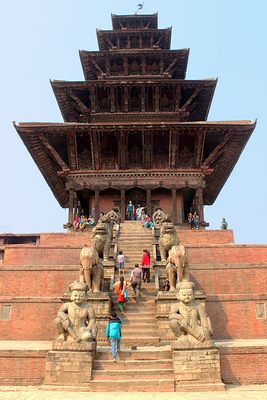About
The imposing Nyatapola Temple stands five tiers tall over Taumadhi Square in the Nepalese city of Bhaktapur, where it was built with time-tested virtuosity at the behest of King Bhupatindra Malla in 1702. While the temple is indeed a splendid relic of treasured Nepalese history, the building’s structure is so solid that it withstood an 8.3 earthquake in 1934, followed by another in 2015, without any significant architectural damage.
This exquisite, pagoda-style edifice comprised of wood and brick, and adorned with magnificent carvings was named Nyatapola after the local Newari words for “five-stepped” (nyata) and “roof” (pola).
The building maintains associations with the deities Bhairava—a ferocious incarnation of the Lord Shiva—and, principally, Siddhi Lakshmi, the Tantric incarnation of “the invincible” goddess Durga, to whom Nyatapola is dedicated.
According to local legend, at a time when Bhairava threatened civilization with annihilation, a desperate king called upon Parvati, the goddess of love, fertility, and beauty. In the form of Siddhi Lakshmi, she thwarted Bhairava with Nyatapola: a far more powerful temple than Bhairava’s neighboring shrine in Taumadhi Square. The original chapel dedicated to Bhairava was a humble construction, added to over time. The temple was destroyed in the earthquake that occurred in 1934 and had to be rebuilt, with a third tier added during reconstruction.
Within the sublime Nyatapola Temple is a shrine dedicated to Siddhi Lakshmi, which is purportedly so formidable that it’s been reserved exclusively for temple priests since it was forged. Additional likenesses of Siddhi Lakshmi can be found in details across the temple—above doors and across the roof’s framework.
Visitors egress the temple via a brick stairway guarded by five pairs of sculpted deities of ascending power: first, the wrestlers Jayamel and Phattu, believed to have possessed superhuman strength; followed by elephants, lions, then gryphons; and finally, just before the temple doors, the goddesses Baghini—the “Tigress,”—and Singhini—the “Lioness.”
Nyatapola was one of several temples built in the states of Bhaktapur, Lalitpur, and Kathmandu during the 18th century. Today, all three former states comprise the Kathmandu Valley, also known as the Valley of the Temples.
Know Before You Go
The Nyatapola Temple is open 24 hours a day, seven days a week, though visitors to the temple during a Nepalese festival or holiday should check beforehand to make sure it's open to the public.
Published
February 1, 2019
Sources
- https://www.magicalnepal.com/trip/manaslu-circuit-trek/
- https://www.breezeadventure.com/pikey-peak-trek
- https://himalayan-masters.com/trip/manaslu-circuit-trek/
- https://www.lonelyplanet.com/nepal/bhaktapur/attractions/nyatapola-temple/a/poi-sig/449979/357114
- https://books.google.com/books?id=lcbUIOTcE18C&pg=PA229&lpg=PA229&dq=goddess+baghini&source=bl&ots=T8PbELxXUc&sig=ACfU3U0ol8xM6as22k85EqAH5PxPUL9ndQ&hl=en&sa=X&ved=2ahUKEwiUydXI1ZXgAhWFd98KHcY1Cg4Q6AEwCHoECAYQAQ#v=onepage&q=goddess%20baghini&f=false
- http://english.ohmynews.com/articleview/article_view.asp?no=272166&rel_no=1
- https://en.wikipedia.org/wiki/Nyatapola#The_Nyatapola_Temple
- https://www.lonelyplanet.com/nepal/bhaktapur/attractions/bhairabnath-temple/a/poi-sig/449939/357114













